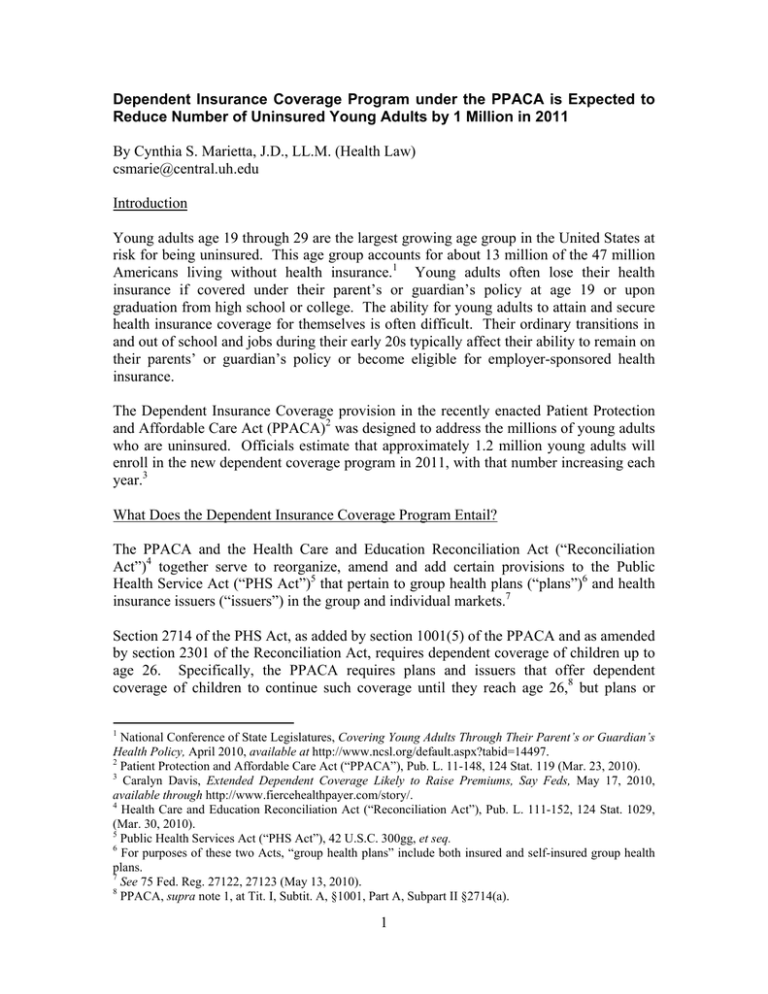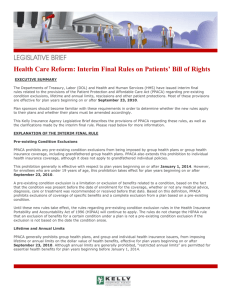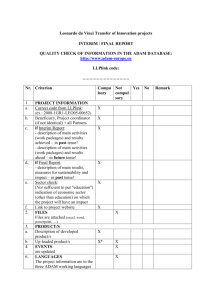Dependent Insurance Coverage Program under the PPACA is Expected to
advertisement

Dependent Insurance Coverage Program under the PPACA is Expected to Reduce Number of Uninsured Young Adults by 1 Million in 2011 By Cynthia S. Marietta, J.D., LL.M. (Health Law) csmarie@central.uh.edu Introduction Young adults age 19 through 29 are the largest growing age group in the United States at risk for being uninsured. This age group accounts for about 13 million of the 47 million Americans living without health insurance.1 Young adults often lose their health insurance if covered under their parent’s or guardian’s policy at age 19 or upon graduation from high school or college. The ability for young adults to attain and secure health insurance coverage for themselves is often difficult. Their ordinary transitions in and out of school and jobs during their early 20s typically affect their ability to remain on their parents’ or guardian’s policy or become eligible for employer-sponsored health insurance. The Dependent Insurance Coverage provision in the recently enacted Patient Protection and Affordable Care Act (PPACA)2 was designed to address the millions of young adults who are uninsured. Officials estimate that approximately 1.2 million young adults will enroll in the new dependent coverage program in 2011, with that number increasing each year.3 What Does the Dependent Insurance Coverage Program Entail? The PPACA and the Health Care and Education Reconciliation Act (“Reconciliation Act”)4 together serve to reorganize, amend and add certain provisions to the Public Health Service Act (“PHS Act”)5 that pertain to group health plans (“plans”)6 and health insurance issuers (“issuers”) in the group and individual markets.7 Section 2714 of the PHS Act, as added by section 1001(5) of the PPACA and as amended by section 2301 of the Reconciliation Act, requires dependent coverage of children up to age 26. Specifically, the PPACA requires plans and issuers that offer dependent coverage of children to continue such coverage until they reach age 26,8 but plans or 1 National Conference of State Legislatures, Covering Young Adults Through Their Parent’s or Guardian’s Health Policy, April 2010, available at http://www.ncsl.org/default.aspx?tabid=14497. 2 Patient Protection and Affordable Care Act (“PPACA”), Pub. L. 11-148, 124 Stat. 119 (Mar. 23, 2010). 3 Caralyn Davis, Extended Dependent Coverage Likely to Raise Premiums, Say Feds, May 17, 2010, available through http://www.fiercehealthpayer.com/story/. 4 Health Care and Education Reconciliation Act (“Reconciliation Act”), Pub. L. 111-152, 124 Stat. 1029, (Mar. 30, 2010). 5 Public Health Services Act (“PHS Act”), 42 U.S.C. 300gg, et seq. 6 For purposes of these two Acts, “group health plans” include both insured and self-insured group health plans. 7 See 75 Fed. Reg. 27122, 27123 (May 13, 2010). 8 PPACA, supra note 1, at Tit. I, Subtit. A, §1001, Part A, Subpart II §2714(a). 1 issuers are not compelled to offer dependent coverage if they do not already do so.9 The PPACA will not supersede any State law that imposes stricter requirements on health insurance issuers in connection with group or individual health insurance coverage.10 The PPACA also requires the Department of Health and Human Services (HHS) to issue regulations that define the “dependents” eligible for coverage under this rule.11 On May 10, 2010, HHS released interim final regulations on the dependent coverage extension requirement included in the PPACA.12 The interim regulations were published in the Federal Register on May 13, 2010, and became effective on July 12, 2010.13 The interim regulations generally apply to group plans and issuers for plan years beginning on or after September 23, 2010, and they generally apply to individual insurers for policy years beginning on or after September 23, 2010.14 Comments on the interim regulations are due on or before August 11, 2010.15 The HHS Secretary, Kathleen Sebelius, has called upon leading insurance companies to voluntarily begin covering young adults before the September 23, 2010 implementation date to avoid gaps in coverage for new college graduates and other young adults.16 This would save administrative costs of dis-enrolling and re-enrolling these young adults between May 2010 and September 2010. So far, 65 insurers have volunteered to do so.17 Overview of Interim Regulations Relating to Dependent Coverage of Children to Age 26 under the Affordable Care Act The interim regulations and the preamble to the interim regulations address the following key provisions: 1. Restatement of Dependent Coverage General Rule The interim regulations restate the general rule: Group health plans or health insurer issuers in the group and individual markets that offer dependent coverage 9 U.S. Dep’t of Health & Human Servs., Young Adults and the Affordable Care Act, available at http://www.hhs.gov/ociio/regulations/adult_child_faq.html. The vast majority of plans, however, offer dependent coverage and many issuers offer family policies in the individual market. Id. 10 See 75 Fed. Reg. at 27123. The requirements of the PPACA are not to be construed to supersede any provision of State law which establishes, implements, or continues in effect any standard or requirement solely relating to health insurance issuers in connection with group or individual health insurance coverage except to the extent that such standard or requirement would prevent the application of a requirement of the PPACA. Id. 11 PPACA, supra note 1, at Tit. I, Subtit. A, §1001, Part A, Subpart II §2714(b). 12 See 45 C.F.R. Parts 144, 146, and 147, Interim Final Rules for Group Health Plans and Health Insurance Issuers Relating to Dependent Coverage of Children to Age 26 under the Patient Protection and Affordable Care Act. 13 75 Fed. Reg. at 27122. 14 Id.; see also PPACA, supra note 1, at Tit. I, Subtit. A, §1004(a). 15 Id. 16 Young Adults and the AffordableCare Act, supra note 7. 17 Id. 2 of children must make such dependent coverage available for children until they reach age 26.18 For purposes of the interim regulations, dependent coverage means coverage of any individual under the terms of a group health plan, or group or individual health insurance coverage, because of the individual’s relationship to a participant or primary subscriber. The term “participant” is used in the plan or group insurance market, and the term “primary subscriber” is used in the individual insurance market.19 2. Definition of “Dependent” Who is Eligible for Coverage: A group plan or health insurer must base eligibility for dependent child coverage in terms of the relationship between the child and the participant (or primary subscriber) and may not deny or restrict coverage based on factors, such as financial dependency on the participant (or primary subscriber), residency with the participant (or primary subscriber), student status, employment, marital status, or eligibility for other coverage (except under the pre-2014 “Grandfathered Health Plan” described below in paragraph 6).20 3. Coverage of Grandchildren/Son or Daughter-in-law Not Required: Plans and issuers are not required to make coverage available for the children or spouse of a child receiving dependent coverage.21 4. Uniformity Irrespective of Age: The terms of the plan or insurance coverage providing dependent coverage cannot vary based on the age of the child, except for a child who is age 26 or over. The interim regulations give these examples: Surcharges for coverage of children under age 26 are not allowed unless the surcharges apply to all children regardless of age (up to age 26). Benefits may not vary for any child under the age of 26.22 5. Transitional Rules for Dependent Coverage: The Transitional Rules apply to the following children: 18 Id. at 27136, 27138. Id .at 27123 n.4. 20 Id. at 27136, 27138. 21 Id. 22 Id. 19 3 (1) Children whose coverage ended or were denied coverage or were not eligible for coverage because of their age; and (2) Children are now eligible for coverage on September 23, 2010.23 The following rules apply to the above-referenced children: 6. (a) Opportunity to Enroll: The plan or issuer must give eligible children the opportunity to enroll with a special 30-day enrollment period. The plan or issuer must provide written notice of the opportunity to enroll, and the enrollment period must begin not later than the first day of the first plan year, beginning on or after September 23, 2010 (or in the individual market, on the first day of the first policy year, beginning on or after September 23, 2010).24 (b) Effective Date of Coverage: Coverage for individuals enrolling under the special enrollment rules must take effect no later than the first day of the first plan year, beginning on or after September 23, 2010 (or in the individual market, the first day of the first policy year, beginning on or after September 23, 2010).25 (c) Treatment of Enrollees in Group Health Plan: Any child enrolling under these transition rules is treated as a “special enrollee” as provided in HIPAA, which means the child must be offered all of the benefit packages (with the same benefits, cost-sharing requirements, and premiums) available to similarly situated individuals who did not lose coverage because of cessation of dependent status.26 Special Rule for Grandfathered Health Plans: “Grandfathered health plans” are the plans or coverage existing as of the March 23, 2010 enactment date of the PPACA. For plan years before January 1, 2014, grandfathered health plans may exclude an adult child if the adult child is eligible to enroll in an employer-sponsored health plan other than a group health plan of a parent. For plan years on or after January 1, 2014, grandfathered health plans must comply with all requirements of the general rule. 27 The preamble to the interim regulations state that additional regulations relating to “grandfathered health plans” are expected to be published in the “very near 23 Id. at 27136-37, 27138-39. Id. 25 Id. 26 Id. at 27137, 27139. 27 Id. at 27137, 27139-40; see also Reconciliation Act, supra note 2, at Tit. II, Subtit. B, § 2301. 24 4 future” and will clarify the changes necessary to comply with the PHS Act § 2714.28 7. Policy Year: For individual insurance policies, the regulations substitute the term “policy year” for “plan year” for purposes of the defining the period of coverage in the individual health insurance market. The regulations define “policy year” as the 12 month period designated in the policy documents, or if no year is designated or no document is available, the deductible or limit year used under the coverage. If deductibles or other limits are not imposed on a yearly basis, the policy year will be the calendar year.29 Implications for Texas Group Health Plans and Health Insurance Issuers in the Group and Individual Markets Plans and issuers will be required to amend their plans and policies to: Define the “dependents” eligible for coverage, as consistent with the interim regulations. Ensure timely and proper written notice of the availability of dependent coverage and the opportunity to enroll (for at least 30-days), as consistent with the interim regulations. The written notice must include a statement that children are now eligible to enroll in the plan or coverage. The notice may be provided to the employee on behalf of the employee’s child and may be included with other enrollment materials as long as the statement is prominently displayed. Treat enrolled dependent children as “special enrollees” as provided under the HIPAA regulations, and as consistent with the interim regulations. This means the dependent child must be offered all of the benefit packages (with the same benefits, cost-sharing requirements, and premiums) available to similarly situated individuals who did not lose coverage by reason of cessation of dependent status. U.S. Young Adults Potentially Affected by Extending Dependent Coverage to Age 26 The U.S. Census Bureau reports the United States currently has a population of over 309 million individuals.30 The HHS, the Internal Revenue Service, and the Department of Labor (collectively the “Departments”) estimate there are currently approximately 29.5 28 Id. at 27124. Id. at 27125, 27138. 30 U.S. Census Bureau, available at http://www.census.gov (last accessed May 21, 2010). 29 5 million young adults between the ages 19-25 in the United States.31 This means roughly 10 percent of the U.S. population is in the 19-25 young adult age range. Of those individuals, approximately 2.4 million, or 8 percent, of the young adults in this age group in the U.S. might be affected by the dependent coverage provision.32 The Departments estimate that approximately half that group, or 1.2 million young adults, will enroll in the new dependent coverage in 2011, with that number increasing each year.33 Expanding coverage options in the 19-25 age young adult population should decrease the number of uninsured. This, in turn, should decrease the cost-shifting of uncompensated care onto those with insurance, increase the receipt of preventive health care, and provide more timely access to high quality care, and thus, resulting in a healthier population.34 Extended dependent coverage will also permit greater job mobility for the young adult population as their insurance coverage will no longer be tied to their own jobs or student status.35 The HHS estimates the interim regulations are expected to increase the cost of employer sponsored health insurance (“ESI”) by 0.7 percent in 2011 and 1.0 percent in 2012 and 2013. The estimated cost for each dependent will be $3,380 in 2011, $3,500 in 2012 and $3,690 in 2013.36 Individuals purchasing family coverage directly from an insurer, as many self-employed parents do, may face an additional premium. Texas Young Adults Potentially Affected by Extending Dependent Coverage to Age 26 In Texas, only those adult children who are 25 years of age potentially may be affected by the dependent coverage provision. This is because the law in Texas requires a health benefit plan to extend health insurance coverage to an adult child through the age of 24 years, regardless of whether the child is enrolled as a student at an academic institution.37 Health care benefit plans may allow coverage for children 25 years of age or older if they so choose. If a health benefit plan offers coverage for a child 25 years of age or older but requires as a condition of coverage that the child be a full-time student at an educational institution, the plan must adhere to certain coverage requirements.38 There are no 31 75 Fed. Reg. at 27127-28. Id.at 27128. Approximately 1.8 million in this group are currently uninsured, and .6 million are currently covered by their own non-group coverage. 33 Caralyn Davis, Extended Dependent Coverage Likely to Raise Premiums, Say Feds, May 17, 2010, available through http://www.fiercehealthpayer.com/story/. 34 75 Fed. Reg. at 27127. 35 Id. 36 Id. at 27130. 37 TEX. INS. CODE ANN. § 1503.003(a) (Vernon 2009). Adult children who are incapable of self-sustaining employment because of mental retardation or a physical disability and who are dependent on the insured for support and maintenance are not subject to this limiting age. See TEX. INS. CODE ANN. § 1201.059(a). See also TEX. INS. CODE ANN. § 846.260, which makes dependent status available for an unmarried child up to age 25 under a multiple employer welfare arrangement plan. 38 TEX. INS. CODE ANN. § 1503.003(b) (Vernon 2009). 32 6 reported census statistics on the number of young adults in Texas who are age 2539 and could be potentially affected by the PPACA dependent coverage provision. In addition to Texas, there are at least 30 other states that have laws that allow parents to extend their health insurance coverage to dependents beyond the typical limiting ages of 19 through 22.40 Each state has its own variation of extension coverage requirements.41 Several states, like Texas, set the limiting age at 24 years.42 Conclusion In Texas, the extended dependent coverage provision under the PPACA will collectively impact: (1) group health plans and health insurance issuers in the group and individual markets, and (2) the young adult population ages 19-25 and their parents. Young adults and their parents should seek further education about this program and ask their employers and issuers about whether the early stop-gap coverage option before September 23, 2010 is available. If not, young adults and parents need to watch for notice of the special open enrollment period beginning on or after September 23, 2010. Health Law Perspectives (July 2010) Health Law & Policy Institute University of Houston Law Center http://www.law.uh.edu/healthlaw/perspectives/homepage.asp The opinions, beliefs and viewpoints expressed by the various Health Law Perspectives authors on this web site do not necessarily reflect the opinions, beliefs, viewpoints, or official policies of the Health Law & Policy Institute and do not constitute legal advice. The Health Law & Policy Institute is part of the University of Houston Law Center. It is guided by an advisory board consisting of leading academicians, health law practitioners, representatives of area institutions, and public officials. A primary mission of the Institute is to provide policy analysis for members of the Texas Legislature and health and human service agencies in state government. 39 In 2009, the reported estimated population in Texas was 24,782,302. See U.S. Census Bureau, Texas Quick Facts, available at http://quickfacts.census.gov/qfd/states/48000.html (last accessed May 21, 2010). 40 National Conference of State Legislatures, Covering Young Adults Through Their Parent’s or Guardian’s Health Policy, April 2010, available at http://www.ncsl.org/default.aspx?tabid=14497. 41 Id. 42 Id. 7





